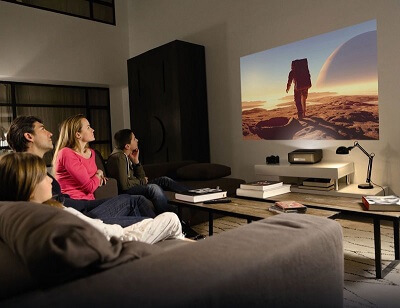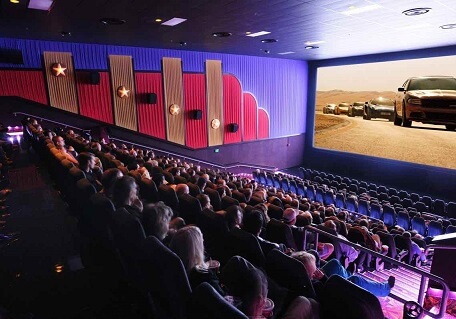What is a Projector?
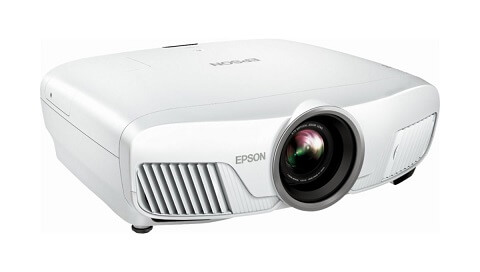
A projector is an output device that is capable of connecting to a computer, which may be an other option for a monitor or television in terms of displaying pictures to a large number of people. It takes images generated by a Blu-ray player or a computer and projects them onto a large surface like a wall or white screen. Projectors come in many shapes and sizes and are used in conditions like a classroom, home cinemas, office training or presentation sessions, etc. The projector looks like the below picture.
Commonly, projectors come a few inches tall and about a foot long and wide. They may be portable and freestanding and can be mounted on ceilings. Ceiling-mounted projectors come in a large size with a long-distance like 30 feet or more. The main applications of these kinds of projectors are places of worship, conference rooms, classrooms, and auditoriums.
On the other hand, some of the projectors have the potential to support Wi-Fi and Bluetooth conectivity, and most projectors are designed in a way that they can have different input sources, such as VGA ports for older devices and HDMI ports for newer equipment.
In the early time, there were needed much high amount thousands of dollars for high-quality projectors, and more than a hundred dollars were required for bulbs alone. In modern times, the cost of projectors has decreased, like a bright, high-quality projector has been reduced to a few hundred dollars with the help of LCD and LED light sources.
Front vs Rear Projection
Projectors can be used for displaying pictures or videos on the front or rear. The screen is the difference between both types of projection, which is semi-transparent grey for rear projection and non-transparent white for front projection. In the front projection, the pictures are sent to the front of the screen from the audience. This process does not need an empty space back side of the screen; therefore, this process is most common.
In the rear projection, the pictures are sent from behind the screen toward the audience. This method provides better contrast as compared to front projection and is less affected by ambient light. Commonly rear projection is used in commercial areas where more space is available and also used in outdoor settings.
Types of Projector
The LCD (liquid crystal display) and DLP (digital light processing) are two common types of projectors. However, CRT (cathode ray tube) projector is another type of projector, which was popular in the earlier times of projectors. In modern times, CRT projectors are no longer in use; because they provided low light output and came in a large size.
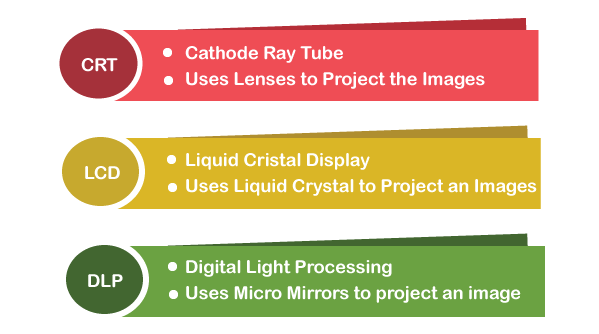
Cathode Ray Tube (CRT)
A CRT, which stands for Cathode Ray Tube projector, is a video projecting device that uses a cathode ray tube (which is small and high-brightness) as the image generating element. A Lens is kept in front of the CRT face through which the image is focused and enlarged onto a screen. In the early 1950s, color CRT projectors came on the market for the first time. Instead of a single-color CRT, most of the modern CRT projectors have colored (red, green, and blue) CRT tubes and their own lenses to generate color images and commonly come with color features. An example picture of a CRT projector is given below.
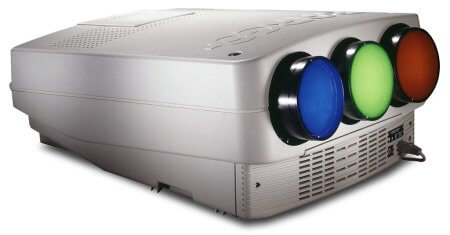
CRT projectors are not commonly in use today, as they consume high electricity and are heavy in weight, and large in size. Also, they are not portable. Although according to users, the picture quality of CRT projectors is brilliant, it may be tricky and difficult to set up a CRT projector at the initial stage. As compared to newer technologies, the projectors are capable of compatible with new improvements; hence, they are nevertheless.
Liquid Crystal Display (LCD)
An LCD projector is a type of projector based on liquid crystal displays, which is widely used in business seminars, presentations, and meetings. They utilize liquid crystal to display images, data or video, and function on transmissive technology. LCD projectors have excellent color reproduction and are cheaper to produce, which makes them more popular as compared to many alternatives. Generally, these kinds of display panels are used in many devices, such as cell phones, portable video games, Laptops, computers, and TVs. Comparing with CRT technology, the display in LCD technology is much thinner. The below picture represents how looks an LCD projector.
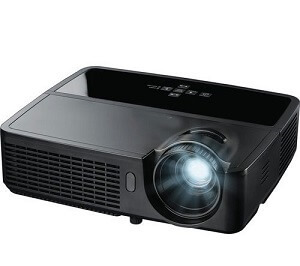
Digital Light Processing (DLP)
DLP projectors are utilized for front and back projection units and can be classified as one-chip or three-chip. Over 16 million colors can be produced by one-chip DLP projectors, whereas more than 35 trillion colors can be produced by three-chip models, which makes the projector capable of providing more lifelike and natural images. It is used in organizations and classrooms in terms of front projectors and also utilized for back projection in TVs. The below image is an example of a DLP projector.
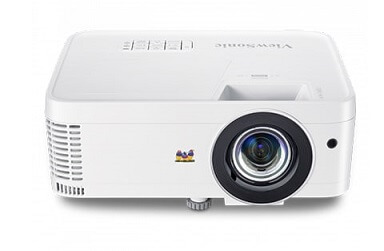
Uses for Projectors
Actually, the applications of a projector depend on the projector type you have. Generally, projectors can be used to project video, slides, and images onto a screen and also used in business meetings, conferences, classrooms, and churches for presentation. There are various kinds of projectors; some of them can be used for different purposes, and even one projector can be used for some other objectives. For example, mostly the use of a video projector is not uncommon, which is usually used in home theaters. The main applications of projectors used in daily life are given below:
- Educational and Classroom: Overhead projectors can be suitable for educational purposes in classrooms in terms of presentation. They offer you many benefits in order to do student presentations; these projectors are used by many public schools and used for meetings, note-taking, plays on theaters, announcements, club activities, etc. Furthermore, similarly “vintage” slide projectors can also be used for slideshow. From 2,000 to 3,000 lumens are included in the video projectors, which is the higher number as compared to the theater projector.
These projectors are useful in terms of applying in a classroom where the large number of students available. Even it has an easy installation process and not much heavy. Additionally, these projectors can be put in the front of the screen rather than the backside of the classroom because these projectors are short-throw projectors and allow for short-range movement. - Home Theater: The aspect ratios like Letterbox (1.85:1), Video (4:3), Cinema (2.35:1), Square (1:1), HDTV (1.78:1), and NTSC (1.33:1) can also provide by this projector. The different type of screens is covered by different aspect ratios and the different video types you might need. It also has various input sources such as HDMI, VGA (D-Sub 15), USB-B, 5BNC, etc. A projector can be used for Internet streaming and videogames as well as projecting HD televisions, as you see in the below picture.
- Advertising and Art Installation: Another use of projectors is advertisements; they play an important role in any business in terms of promoting any business. Because they offer big pictures on the screen, which attracts people, as compared to projectors, the billboard poster with lights to showcase advertisements are used much, and literal gigantic computer screens, the neon sign showcasing various advertisements and commercials at the same time. However, it is an option to advertise your product with a better pictorial form on the screen or wall, which may help to increase your production.
Projectors can be used to project commercials by some people, and the old open-parking drive also uses the same way through theaters. Additionally, it can also be used by many modern artists for their art installation projects. They use them with light and shadow in particular on the basis of their requirements. - Professional Theater: Another use of projectors is cinemas or movie houses where a large number of people can watch a movie together. These projectors are film projectors and known as movies or motion pictures.
Earlier projectors were unable to give sound, and they were only capable of showing a moving picture. But with the movies called Talkies, it has changed. Even it became able to display pictures in a color that led to change the silver screen into a Technicolor one. The projectors used in cinemas are focused on stability and emphasizes a low failure rate. Also, its intuitiveness, network functions, user-friendliness, and thermal performance are quite strong as compared to other projectors.
Advantages of projector
There are various benefits of projectors in different-different fields. They cover big and clear image projection and better for eye health as you can watch any picture or video clearly on the screen from appropriate distance to screen. In modern times, there is no better way to enjoy new shows and movies at your own home. A projector offers you the benefit of watching any movie by way of a home theater system. The advantages of the projector include:
Customizable Screen Size
As compared to TVs, projectors are beneficial as they operate on any surface, whereas television needs to set in one place. You can adjust your projector screen to any size, large or small, accordingly. Also, regardless of projector size, its screens are not static. Furthermore, it is a better alternative for a large size television, 60″ plasma TV. They can be operated with some of the room lights on, and they provide picture very bright that look attractive.
Huge Images
There is a distinct size maximum in the case of television, whereas projectors are not being restricted by an outer limit. As compared to other home entertainment alternatives, another advantage of the projector is that these projectors are not restricted in the size. Comparing with TV counterparts, the size of projector screens is large at their base level. Unlike flat-screen TVs or rear-projection TVs, projectors are capable of producing stunning pictures at sizes of 90″ to 120″ diagonal.
Eye Comfort
In respect of eye comfort, projectors provide two-fold benefit as compared to TVs as projectors display large pictures, which even can be seen clearly from far that led to eye comfort. Because comparing small letters, it is much easy to read large letters. Hence, projectors offer the inherent advantage of larger screen sizes. Similarly, a larger screen is very easy to watch as compared to a small one. Screen size plays an important role in influencing eye comfort. Also, when you look at projected images, your eyes feel more comfortable.
Actually, due to the effect that reflected light from the projector, the eye feels comfortable that does not include televisions as they utilize emitted light. There is another factor about eye comfort with the projector that is the distance between the viewer and the screen. Because when you see any too small picture that can be caused to eyestrain, but projector screen prevents you to eyestrain. Thus, project users become less common as they are capable of projecting larger images.
Compact Size
Today the size optimization of devices is dependent upon manufacturers, whether it be projectors, TVS, or phones. While in earlier days, phone size was very large like wall-mounted bricks; over the times, they are manufactured now in a small size that can be fit into your pocket. On the other hand, the projector size used for home entertainment is a non-issue; therefore, they have never had a requirement for such a transformation.
Home entertainment projectors are manufactured in size like a laptop. So, carrying a TV with one hand to the desired location may be hard, and it cannot project images on the desired surface.
Furthermore, projectors are also even made in short-throw that led to placing them on a shelf within close range of the projection surface. Comparing with the presence of TVs that is stable, projectors provide you the benefit to maintain a more subtle presence as they come in a small size.
Portability
Home entertainment projectors are not only small in size; they are also lightweight, containing a weight of between 2 and 20 lbs. Therefore, if the average projector owner needs to carry it somewhere if needed, he/she has no problem while carrying it. Consider a large screen size television that is 45-inch and contains a weight of around 30 lbs. It is not much easy to hold and carry somewhere. In this condition, the projector is more superior and beneficial as compared to these kinds of televisions.
For example, you have a plan to watch a movie at your friend’s house; or due to a warm summer evening, you want to do an outdoor screening, you can do it very easily with the projectors. It only needs electricity to access and a decent surface to project onto.
Cost
For home entertainment, projectors can be bought at reasonably priced considering the technological and practical advantages of projectors. Also, it is not as that projectors cannot come with a very high price. But the cost/benefit ratio is quite good at the base level.
Disadvantages of Projectors
Although there are multiple advantages of projector in different-different fields, it also has some disadvantages; which are as follows:
Dark Room
As the images are lighter and sharper; so, the projector shows perfect pictures when it is in light-low settings. But it can be a limitation in some places like the classroom; you may be unable to make notes properly and might feel sleepy in the darkroom. Also, if you are in the conference room, there may be a drawback of using a projector that you will not get a better picture quality as getting a completely dark room is difficult.
Maintenance
As compared to TVs, the maintenance of home theater projectors can be much higher. Also, the lamp needs to be changed on the basis of the type and use of a projector. Hence, its maintenance is higher.
Separate Speakers
A video projector may have very low audio that is not suitable for watching movies or other videos or does not contain a sound that led to having to include a separate speaker. Therefore, you have to pay a cost to buy a separate speaker.
Ceiling Mount Projectors
You should keep in your mind that the installation process might be a little overwhelming if you want to set a ceiling-mounted projector due to having less space on your TV stand. In this situation, you may need another person to help you out. Additionally, a separate installation process will be required for a projector screen.
History of the Projectors
In modern times, projectors play a crucial role in offices, homes, classrooms, and commercial establishments. They attract users by providing realistic and huge pictures and enable them to immerse themselves in the world of their favorite shows and movies or other kinds of videos. Over the years, projector technologies have grown rapidly because of continuous research and innovation. As the projector produces colorful images, similarly, its evolution is also colorful and vibrant.
Pre-Computer Era
The foundation of the development of modern projectors was laid through these devices. Magic lantern was a device that was much like a projector, which was created by a Dutch scientist, Christian Huygens, in 1659. In the education and entertainment domains, one of the first devices of image projecting was magic lanterns that got more popularity.
Later the opaque projector was developed by engineer Leonhard Euler and Swiss physicist in around 1756, which was also called the episcope. To project an image or an object on the screen, they were placed inside the projector.
With time, the megascope, a device, was introduced by a French scientist, Jacques Charles. It was mainly used by Jacques Charles for lectures and worked like an opaque projector.
1940s to 1960s
The development of the earliest computers was shown in the decades from the 1940s to the 1960s. Also, different types of optical projectors were witnessed in decades. For projecting pictures or objects, optical mechanisms and bulbs were used by these projectors.
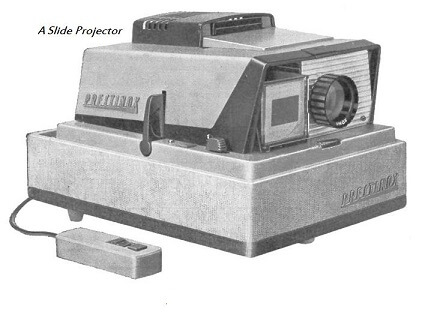
Slide Projectors
During that era, slide projectors were one of the initial projectors to become more common. The light projected a large image on the screen by passing through the slide onto a directing lens. During the decade, in educational institutions as well as homes, slide projectors became common.
Overhead Projectors
The overhead projectors were introduced a few years later to the slide projectors, which were a variant of the slide projectors. They functioned much like the slide projector. For projecting pictures or objects on the screen, the high light is passed through a condensing lens onto the object.
However, rather than slides, these projectors utilize transparencies, which are transparent sheets. And, they have a size similar to the paper sheets. For projecting images, they have to be placed face-up on the projector and could be drawn or printed on these transparent sheets.
During World War II, overhead projectors were commonly used in offices and educational institutions as well as in the US military training.
1970s to 1990s – Beginning of the Digital Era
It was the era that some of the earlier digital formats began to introduce. And, some groundbreaking was discovered, and hardware and software innovations gained speed. Modern projectors that were discovered in this era still used refined versions of the technologies.
Document Cameras
In the 1970s and 1980s, document cameras were introduced that are widely used projecting devices. These devices are capable of capturing images in real-time and display them on a screen as they have a high-resolution camera. Also, they provide the benefit of connecting with an interactive whiteboard or a monitor. These cameras allow the users to enlarge highly detailed images or small print as they contain a zoom feature.
DLP Projectors
In the projector landscape, Digital Light Processing (DLP) technology was an important improvement.
In 1987, the first DLP chip was invented by Dr. Larry Hornbeck that was known as the Digital Micromirror Device (DMD). A number of mirrors are included in the device, wherein each mirror functions for projecting one pixel on the screen. For producing images, the mirrors reflect light onto the projector screen. On the basis of the image that has to be output, the alignment of the mirrors is controlled digitally.
Commercially, DLP projectors were available in 1996 that used a single DLP chip. Later, the DLP projectors became commonly used devices in different applications like education, entertainment, and commercial ones. Due to their affordability and picture quality, they are still widely used in offices, home theaters, and educational institutions.
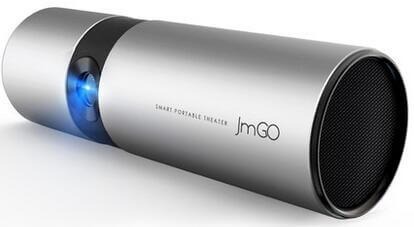
LCD Projectors
LCD projectors were developed by the introduction of LCD technology. While various decades ago liquid crystals were discovered, but displays made by liquid crystals were commercially available in the 1960s and 1970s. In 1972, at the SID Conference, an early prototype of an LCD projector was presented. It was created with a matrix-addressed LCD by Peter J. Wild, which was a modified slide projector.
Since the late 1960s, Gene Dolgoff had been working on creating an LCD projector. A prototype LCD projector was completed by Gene Dolgoff in 1984; because he had only able to complete this prototype. Later in 1987, he patented it and improved upon his design. And in 1988, he began his company Projectavision, Inc. The “Imagina 90,” the first commercial LCD projector, was available in the market in 1990.
In modern times, LCDs for projectors are manufactured by Sony and Epson, which are considered major companies to manufacture LCDs for projectors.
The 2000s and Beyond
In the last couple of decades, projector technologies have been refined by manufacturers in order to produce picture quality. The enhanced versions of the LCoS, LCD, and DLP technologies are used by the latest projectors. For allowing projectors to produce lifelike images or objects, there have been some changes in properties of the projectors, such as resolution, brightness, and contrast ratio.
4K and UHD projectors
Manufactures became able to produce high-resolution displays due to continuous improvement in technologies. In the early 2000s, 4K and UHD projectors were commercially available for applications like digital cinema. Also, in recent years, they have attracted consumers with their own features. In 2004, the first 4K projector was introduced by Sony for cinemas. After its sometimes, some other products were also introduced by other manufacturers.
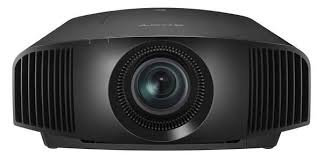
PICO Projectors
The continuous evolution of projector technologies has made capable of manufactures to build lightweight and portable projectors. In 2012, the DLP PICO technology was introduced by Texas Instruments. The new DLP chip can be implanted into devices such as tablets and smartphones as its size is smaller as compared to the standard chip. This technology has made a change in the revolution of projectors that allows the creation of smart projectors, which are portable and small in size. Also, Pico LCD and LCoS technologies are being used in several mall form-factor projecting devices.
Laser Projectors
These projectors enable projectors to produce high-quality images as they produce a highly coherent beam of light. Additionally, they are strong in terms of longer life span and generate less heat. Initially, laser projectors were designed only for commercial uses. Later in 2013, 4K laser projectors were begun available in cinemas.
Even in recent years, laser TVs also became available. The images that are par with plasma and LCD TVs are produced by laser TVs, which became the reason in order to increase their popularity.
Smart Projectors
Except for the projecting mechanism, these projectors contain dedicated storage, RAM, and processor. They have the potential to display the pictures from their storage and come by default with an OS such as the Android operating system. Also, with the help of SIM or Wi-Fi networks, these projectors can be connected to the Internet. They can be carrying somewhere very easily as they are lightweight and super portable.
The development for the projectors is continuously in a process that has been continued for various decades. The enhanced technology has improved the picture quality that has to be produced by the projector as well as made projectors more affordable. Finally, projectors are going to be better from hereon as they are used in different areas today.
How a Projector Works
A projector works with the help of a small transparent lens. There are various technologies available that can display the images or objects from your source media, like using lasers rather than LEDs.
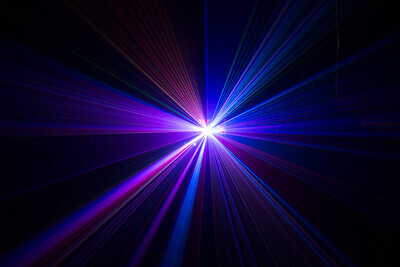
The LCD projector was the projector type that was dominated by projectors primarily used for computer monitor mirroring and business presentations. Due to the tech became more common and available, they were also commonly used as television alternatives. Now, you have prism-like Digital Light Processing (DLP), mirror-based projectors, including the LCD/DLP hybrid projectors, which combine DLP prisms and LCD tech together.
What to look for in a Projector?
When you are planning to buy a projector, you need to consider your specific goals or applications and the price that you can afford. Mainly, determining your budget is the best bet to buy a project. Also, you can adjust things according to your requirements, whether you need a low-latency projector for online first-person shooter gaming purposes or you are willing to torrent for a particular type of projector. Your personal preferences and financial circumstances should work to get you the right projector.


